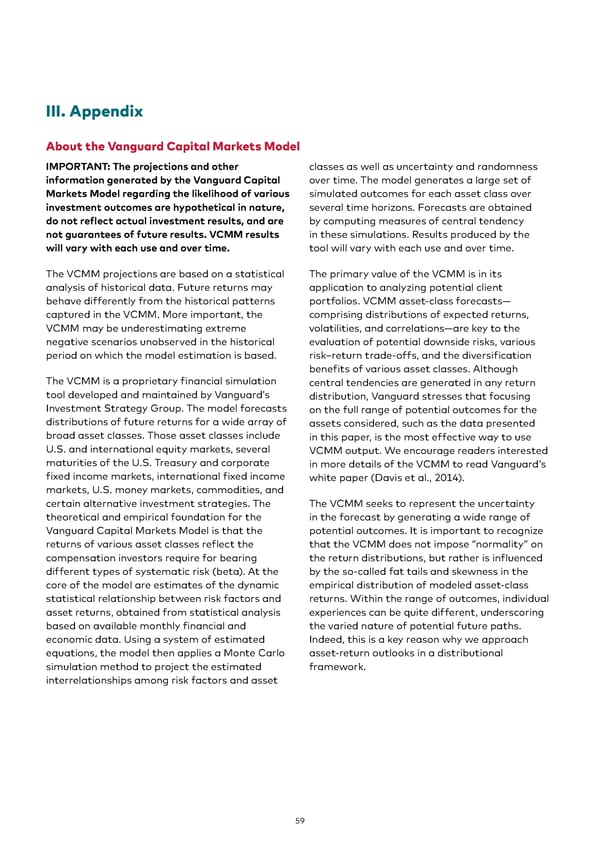III. Appendix About the Vanguard Capital Markets Model IMPORTANT: The projections and other classes as well as uncertainty and randomness information generated by the Vanguard Capital over time. The model generates a large set of Markets Model regarding the likelihood of various simulated outcomes for each asset class over investment outcomes are hypothetical in nature, several time horizons. Forecasts are obtained do not reflect actual investment results, and are by computing measures of central tendency not guarantees of future results. VCMM results in these simulations. Results produced by the will vary with each use and over time. tool will vary with each use and over time. The VCMM projections are based on a statistical The primary value of the VCMM is in its analysis of historical data. Future returns may application to analyzing potential client behave differently from the historical patterns portfolios. VCMM asset-class forecasts— captured in the VCMM. More important, the comprising distributions of expected returns, VCMM may be underestimating extreme volatilities, and correlations—are key to the negative scenarios unobserved in the historical evaluation of potential downside risks, various period on which the model estimation is based. risk–return trade-offs, and the diversification benefits of various asset classes. Although The VCMM is a proprietary financial simulation central tendencies are generated in any return tool developed and maintained by Vanguard’s distribution, Vanguard stresses that focusing Investment Strategy Group. The model forecasts on the full range of potential outcomes for the distributions of future returns for a wide array of assets considered, such as the data presented broad asset classes. Those asset classes include in this paper, is the most effective way to use U.S. and international equity markets, several VCMM output. We encourage readers interested maturities of the U.S. Treasury and corporate in more details of the VCMM to read Vanguard’s fixed income markets, international fixed income white paper (Davis et al., 2014). markets, U.S. money markets, commodities, and certain alternative investment strategies. The The VCMM seeks to represent the uncertainty theoretical and empirical foundation for the in the forecast by generating a wide range of Vanguard Capital Markets Model is that the potential outcomes. It is important to recognize returns of various asset classes reflect the that the VCMM does not impose “normality” on compensation investors require for bearing the return distributions, but rather is influenced different types of systematic risk (beta). At the by the so-called fat tails and skewness in the core of the model are estimates of the dynamic empirical distribution of modeled asset-class statistical relationship between risk factors and returns. Within the range of outcomes, individual asset returns, obtained from statistical analysis experiences can be quite different, underscoring based on available monthly financial and the varied nature of potential future paths. economic data. Using a system of estimated Indeed, this is a key reason why we approach equations, the model then applies a Monte Carlo asset-return outlooks in a distributional simulation method to project the estimated framework. interrelationships among risk factors and asset 59
 Vanguard economic and market outlook for 2023 Page 58 Page 60
Vanguard economic and market outlook for 2023 Page 58 Page 60